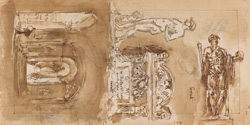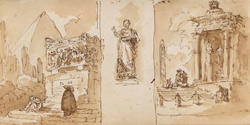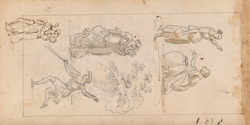Hubert Robert: Roman Sketchbook
Over the course of his lifetime, Robert filled dozens of sketchbooks with rapid drawings and studies. Only three of the sketchbooks are known to be still intact, including one he used in the early 1760s in Rome, now in The Morgan Library & Museum, New York. Forty-one drawings from it are reproduced here. A number of them represent ideas for capriccios (caprices) and feature recognizable monuments of ancient and modern Rome. Among the ones that appear most often (here linked to photographs from the image collections of the National Gallery of Art Library) are the Pantheon, the pyramid of Cestius, Gian Lorenzo Bernini’s colonnade in Saint Peter’s Square, the equestrian statue of Marcus Aurelius, and other sculptures and buildings from the Piazza del Campidoglio on the Capitoline Hill. Also included are quick studies of townspeople and sculptures Robert came across in his wanderings around Rome, including hooded penitents in a religious procession and masked performers from an acting troupe. Many of the drawings show remarkable freedom and fluidity in the way they capture and express Robert’s ideas. The consistency of touch throughout suggests that most of them were made within a very brief span of time—days or weeks rather than years. Very few of the most finished compositions were used for his paintings, suggesting that he regarded the mere act of jotting down these ideas as sufficient.
The exhibition, Hubert Robert, 1733–1808, was on view in the National Gallery of Art's West Building from June 26 to October 2, 2016.
Hubert Robert, Roman Sketchbook, 1760 /1764, bound volume with drawings in various media. The Morgan Library & Museum, New York








































